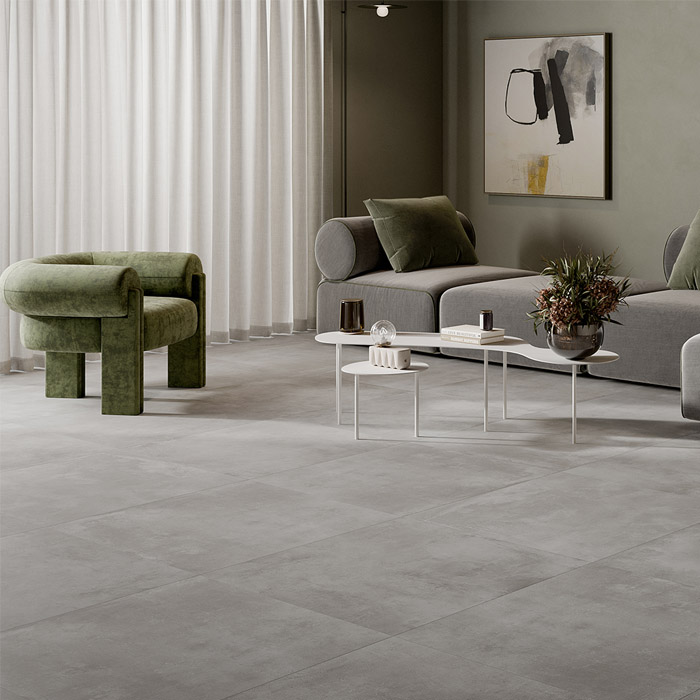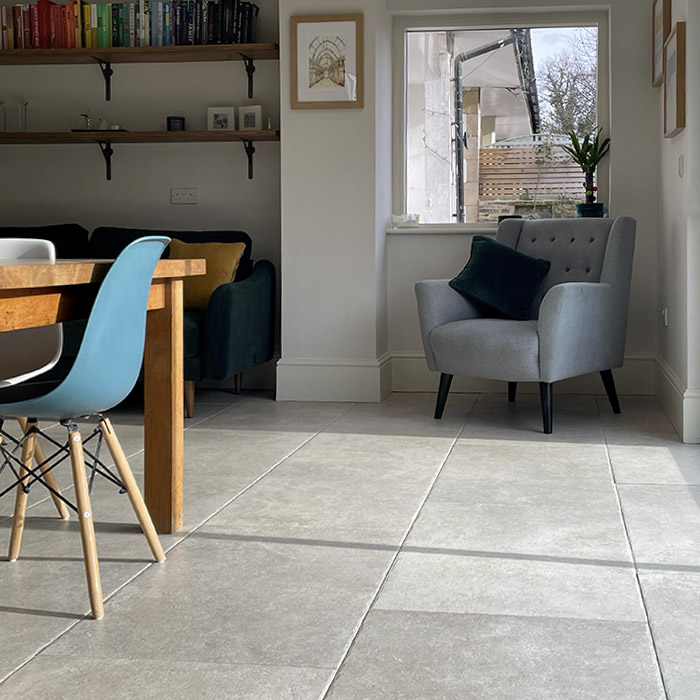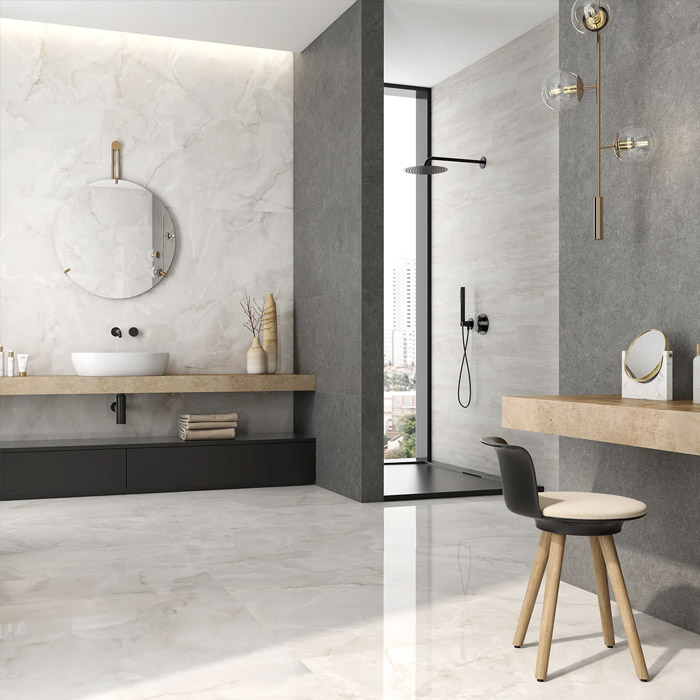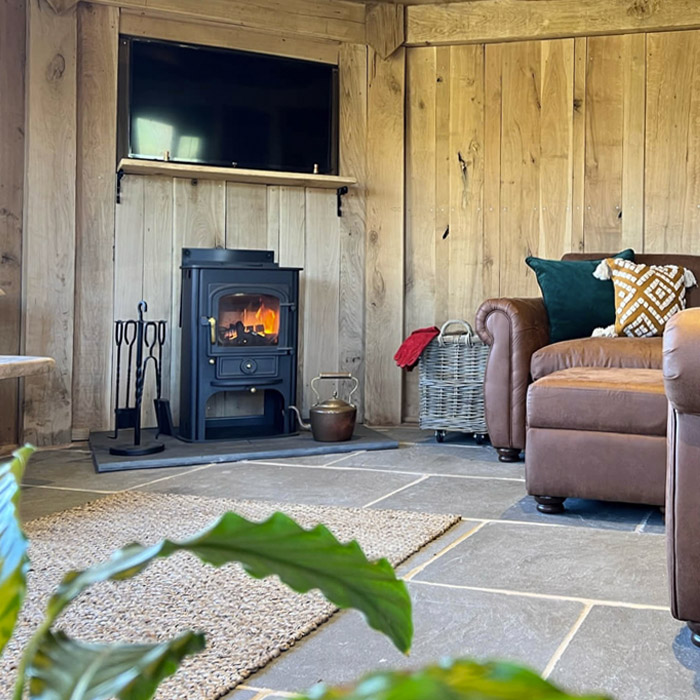Whether it’s the cold winter, rainy spring, or chilly autumn months, there’s nothing more comforting than stepping onto a warm floor, and underfloor heating is the ideal straightforward and cost-effective solution.
However, the success of this heating method hinges on selecting the right tiles that not only complement your aesthetic but also maximise efficiency. In this guide, we’ll reveal the best tiles for underfloor heating, from stone to porcelain.

Grunge Steel Concrete-Effect Porcelain
Are floor tiles suitable for underfloor heating?
Floor tiles can be a great choice for underfloor heating systems over other flooring material types. However, the compatibility of floor tiles with underfloor heating depends largely on the type of tile and the heating system that you have in mind:
- Material: you need to consider which tile materials will conduct and retain heat best, ensuring an efficient transfer to the surface.
- Thickness: think about how thick your tiles are. Thinner tiles will allow heat to transfer more effectively, while thicker tiles may insulate the heat and reduce efficiency.
- Size: tiles with larger surface areas will provide more even distribution of heat, maintaining a comfortable temperature across the entire floor space.

Charterhouse Bianco Antique-Effect Porcelain
Can underfloor heating crack tiles?
Underfloor heating is not likely to cause tiles to crack if the system is installed and used correctly. For example, as long as the temperature rises slowly, appropriate floor tiles can usually withstand very high heats.
However, if the system isn’t installed correctly, and there’s a sudden and significant temperature change, the thermal shock could cause the tile to crack. Factors that can contribute to the risk of tile cracking from underfloor heating systems include:
- Subfloor preparation: a stable and properly prepared subfloor is essential. Any unevenness or movement in the subfloor can put stress on the tiles, leading to cracks.
- Tile type & quality: the type and quality of your chosen tiles matters. You want to opt for tiles that are highly durable and resistant to temperature changes.
- Expansion joints: expansion joints are crucial to allow for the natural movement of tiles as they expand and contract with temperature changes. These help to prevent stress on the tiles and minimise the risk of cracking.
- Proper installation: correct installation by a qualified professional is key. This includes using the right adhesive, ensuring proper spacing, and following industry guidelines for the specific type of tile and heating system.
- Thermal shock: rapid changes in temperature can contribute to thermal shock and increase the risk of cracking. Gradual adjustments in temperature are recommended.
- Heating system compatibility: ensure the underfloor heating system is compatible with the type of tiles you choose. For example, are you tiling over electric underfloor heating or warm water?
What are the best tiles for underfloor heating?
The best tiles for underfloor heating strike a balance between heat conductivity, durability and, of course, aesthetic appeal. To help our customers in your tile buying journey, all of our product pages will state whether a specific tile is suitable for underfloor heating or not. However, let’s take a closer look at where is best to start.
Ceramic & porcelain tiles
Ceramic and porcelain stand out as top contenders if you’re browsing the best tiles for underfloor heating, renowned for their excellent heat conduction properties and resistance to temperature fluctuations.
These tiles efficiently transfer the warmth from heating system to the surface, ensuring a comfortable and consistent temperature throughout the space.
Porcelain tiles are also resilient to temperature fluctuations, minimising the risk of cracking and damage caused by expansion and contraction. And, as a bonus, ceramic and porcelain are easy to clean and maintain!

Onice Bianco Polished Porcelain
Large-format tiles
Large-format tiles are also preferable if you’re tiling over underfloor heating, as they promote an even distribution of heat. The expansive surface area means fewer grout lines, which helps eliminate potential cold spots and ensures a consistent warmth throughout the room.
Natural stone tiles
Natural stone tiles are also an excellent choice, due to their thermal conductivity. The inherent density and thickness of natural stone contributes to its ability to retain warmth, resulting in a sustained and comfortable temperature throughout the space.
However, it is essential to verify specific characteristics of each stone to prevent potential cracking.

Thin tiles
Thinner porcelain tiles are also a great choice for underfloor heating, allowing for quicker heat transfer, meaning that the floor can reach the desired temperature faster. Thinner tiles also typically have lower thermal resistance, ensuring that the heat generated by the underfloor system is not impeded.
Porcelain large-format tiles stand out as top contenders for homes with underfloor heating, thanks to their exceptional thermal conductivity, durability, and ease of maintenance – but you can also find the perfect natural stone to complement your aesthetic. However, no matter what, always check that your desired tile is safe to use for underfloor heating.
Discover more tile advice from our experts, include all you need to know about tiling on underfloor heating screed.

